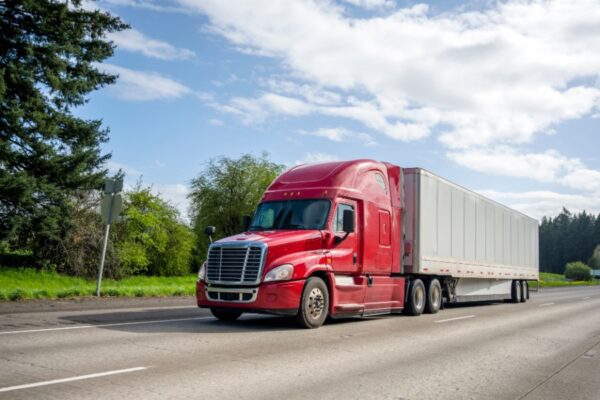The trucking industry comprises businesses that use large commercial motor vehicles (CMVs) to transport a wide range of cargo, including raw materials, product components, and finished goods, along designated routes. This sector is vital to the U.S. economy, moving vast amounts of freight and supporting supply chains across various industries. According to the U.S. Department of Transportation, the trucking industry moves up to 12.5 billion tons of cargo annually, valued at over $13.1 trillion.
In recent years, the trucking industry has continued to promote economic growth. The latest data from the American Trucking Associations (ATA) found that the sector generated $875.5 billion in revenue in 2021, up from $791.7 billion in 2019. Despite this growth, several industry developments could pose challenges in the coming months and years, including driver shortages, social inflation issues, economic concerns and a lack of new CMVs.
With this in mind, it’s critical for trucking businesses to have a clear understanding of the latest sector developments and adjust their risk management practices as needed to maintain operational success. This article provides more information on trucking industry trends to watch.
Driver Shortages
The past few years have been met with labor shortages among businesses of all sizes and sectors. What’s more, the COVID-19 pandemic motivated many employees to reevaluate their job expectations and priorities, thus prompting additional workforce shifts and exacerbating such shortages. The trucking industry is no exception to this trend. According to the ATA, the sector is currently short 80,000 drivers, with this number expected to double to 160,000 drivers by 2030.
Making matters worse, a growing proportion of the trucking workforce is reaching retirement age. Recent research from online recruitment services company Zippia found that the average age of a U.S. commercial truck driver is approximately 48 years old. This demographic shift could create further potential for driver shortages going forward as more employees exit the industry.
Additionally, some states have begun passing legislation to regulate businesses that hire independent contractors, consequently limiting these companies’ available talent pools. For example, California recently passed Assembly Bill 5 (AB5), which requires businesses to classify independent contractors as company employees unless they meet certain qualifications. This means that all businesses operating within the state (including trucking companies) can no longer hire independent contractors unless they are willing to provide such workers with the same rights and benefits as their employees (e.g., minimum wage, health insurance and periodic rest breaks). Looking ahead, states such as Illinois and New York are seeking to pass legislation similar to AB5, presenting additional driver shortage concerns throughout the trucking industry.
While the sector may be able to minimize labor concerns in the future with the assistance of driverless CMVs, this technology isn’t expected to become widely available for some time. As a result, it’s important for trucking businesses to invest in their drivers and implement effective strategies to attract and retain workers.
Possible strategies may include providing competitive wages and benefits; establishing workplace policies that foster a positive and inclusive culture; permitting flexible work arrangements (if possible); leveraging digital platforms in the recruitment process; and offering ample professional development resources (e.g., training and mentorship programs). Above all, trucking businesses should consider exploring unrepresented demographics to help expand their talent pools. For instance, Zippia reported that women account for just 9% of U.S. commercial truck drivers, highlighting substantial recruitment opportunities within the sector.
Social Inflation Issues
In general, social inflation refers to societal trends that influence the ever-rising costs of insurance claims and lawsuits above the overall inflation rate. One of the main factors driving up social inflation issues is the ongoing increase in nuclear verdicts (jury awards exceeding $10 million), especially within the trucking sector.
Specifically, trucking businesses have become more likely to face such verdicts as a result of their commercial drivers and fleets being held responsible for causing third-party property damage, injuries or fatalities on the road. Compounding concerns, the National Highway Traffic Safety Administration confirmed fatal motor vehicle crashes reached record highs in recent years, contributing to nearly 43,000 deaths in 2021 alone and, in turn, creating additional nuclear verdict exposures. According to the American Transportation Research Institute (ATRI), nuclear verdicts have increased nearly tenfold over the past decade, with the average verdict currently sitting at more than $22 million.
Altogether, these trends have prompted a surge in the cost of commercial auto claims across the trucking industry, ultimately leading to elevated insurance rates. The latest ATRI data found that the sector’s commercial auto premium costs per mile jumped by 47% throughout the last 10 years in spite of many trucking companies encountering coverage restrictions, higher deductibles and reduced overall capacity.
Amid rising social inflation issues, it’s crucial for trucking businesses to make safety a top priority among their commercial drivers and fleets and take steps to prevent accidents on the road, thus limiting the likelihood of nuclear verdicts and increased insurance costs. Valuable accident prevention measures may include enforcing routine fleet inspection protocols; adhering to strict driver hiring criteria; enhancing driver safety programs; monitoring drivers’ habits through the use of vehicle technology (e.g., telematics); rewarding drivers for upholding safe behaviors behind the wheel; establishing accident reporting and response procedures; and following an accident review process to address remaining exposures.
Economic Concerns
Widespread inflation concerns have impacted virtually every industry in recent years, evidenced by skyrocketing costs for various goods and services. As it pertains to the trucking sector, data from the U.S. Bureau of Labor Statistics confirmed that nearly all budgetary items among commercial fleet operators jumped in price throughout 2022. For example, the average cost of a new vehicle increased by 10.4%, while the average price of a used vehicle rose by 6.6%. The combination of inflation issues and continued supply chain struggles brought on by the pandemic have also elevated costs for a wide range of vehicle parts, driving up average replacement part expenses by 10%.
In addition to increased vehicle costs, rising fuel and energy expenses have also affected the trucking sector, largely due to the ongoing Russia-Ukraine conflict. According to the U.S. Energy Information Administration, gas prices more than doubled between 2021 and 2022, significantly impacting trucking companies’ operational expenses and hindering their total profitability. In light of these inflation concerns, a growing number of trucking businesses have taken steps to help keep their costs under control, such as promoting fuel-efficient practices across their commercial fleets and keeping CMVs in good condition to avoid unanticipated replacements.
To help minimize overall inflation concerns, the Federal Reserve (Fed) has steadily been hiking up interest rates. Economic analysts predict that the Fed’s efforts will eventually pay off during 2023, with inflation slowly subsiding throughout the year. However, some economic experts have forecasted that rising interest rates and prolonged labor market challenges could lead to a possible recession—a prolonged and pervasive reduction in economic activity—throughout the United States in the near future.
During a recession, consumers may opt to cut costs and purchase fewer goods, potentially lowering demand and taking away business across the trucking industry. In fact, a recent survey conducted by financial services company Provident Bank revealed that more than three-quarters (83%) of Americans are already planning to reduce their spending in the coming year. As a result, trucking companies without substantial revenues, excess reserves and the additional capital necessary to offset extended periods of loss could be more likely to have to make difficult financial decisions to avoid issues such as bankruptcy or insolvency in the months ahead.
To prepare for a potential recession, trucking businesses should consider practices such as establishing concrete financial plans, scaling back certain operations, promoting steady cash flow, ensuring proper debt management, fostering strong connections with stakeholders and leveraging effective marketing strategies. Furthermore, it’s crucial for trucking companies to maintain ample insurance in a recession and secure financial protection against possible losses.
CMV Shortages
Since the initial onset of the pandemic, fluctuating demand for various raw materials, components and finished products has led to significant supply chain concerns. In the scope of the trucking industry, such supply chain issues have contributed to substantial CMV shortages, as vehicle manufacturers have repeatedly struggled to hit production targets.
The sector requires approximately 200,000-250,000 new CMVs to be produced every year to maintain adequate commercial fleets and allow trucking companies to retire outdated vehicles, according to industry experts. Yet, this annual production goal hasn’t been met in several years, leaving many trucking businesses without a sufficient number of new CMVs and forcing them to utilize old vehicles with associated efficiency and safety concerns. While vehicle manufacturers are currently working through the CMV backlog and on track to hit production targets going forward, an upcoming recession could prolong supply chain issues and threaten this progress.
As CMV shortages press on, it has become all the more important for trucking companies to take proper care of their commercial fleets and do what they can to extend the lifespans of their vehicles. This may entail upholding routine fleet maintenance schedules and conducting vehicle repairs as needed.
Conclusion
Overall, there are several trends currently impacting the trucking sector. By staying on top of these developments and taking steps to mitigate their associated exposures, trucking businesses can effectively position themselves to maintain long-term growth and operational success.
Material posted on this website is for informational purposes only and does not constitute a legal opinion or medical advice. Contact your legal representative or medical professional for information specific to your legal or medical needs.



